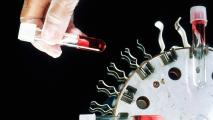Using a special “light-shrinking” material, researchers at UC San Diego say they can enhance any normal light microscope, allowing it to see in “super-resolution.” The leap will allow scientists anywhere to see activity inside living cells, in incredible detail.
“It’s very simple and easy to use,” Zhaowei Liu, an electrical and computer engineering associate professor at UCSD, said in a release. “Just place a sample on the material, then put the whole thing under a normal microscope — no fancy modification needed.”
Small expectations: As AZoOptics, an industry-focused publication, points out, a typical light microscope — like the kind you used in high school — is fine and dandy when looking at live cells.
The problem is they can’t get into detail much smaller than that.
A light microscope usually hits its resolution limit at around 200 nanometers; anything smaller than that won’t be distinguishable as a discernible, single object, Tech Explorist explains.
We’ve got microscopes that can see far smaller than that, of course — but many don’t work with living cells. In an electron microscope, for example, samples must be placed in a vacuum. And we all know nature just abhors those.
“The major challenge is finding one technology that has very high resolution and is also safe for live cells,” Liu said.
Low to high: The technology Liu has landed on is a class of material called “hyperbolic metamaterial” (which, I believe, is what the Fantastic Four’s costumes are made of).
Their technique, published in Nature Communications, coats an ordinary microscope slide with the hyperbolic metamaterial. Made of multiple layers of silver and silica glass, the hyperbolic metamaterial shortens and shatters the light microscope’s light source when it hits each layer; the end result is a birdshot of random, but very high resolution, light patterns.
Those high resolution bits of light light up whatever sample you’re looking at in different ways; the researchers then hoover up all those bits and use an algorithm to piece it all together in nice, high resolution.
Just place a sample on the material, then put the whole thing under a normal microscope — no fancy modification needed.
Zhaowei Liu
Using the hyperbolic metamaterial, the team can get a light microscope’s resolution down to 40 nanometers, a considerable improvement.
Or, to put it another way, “an ordinary light microscope using one of the slides is able to image much smaller objects than was previously possible,” as New Atlas reports.
So far, the researchers have been able to use their light-shrinking slides to see minute details of fluorescently tagged cells, and discern different quantum dots and microscopic, glowing beads from each other.
We’d love to hear from you! If you have a comment about this article or if you have a tip for a future Freethink story, please email us at tips@freethink.com.






